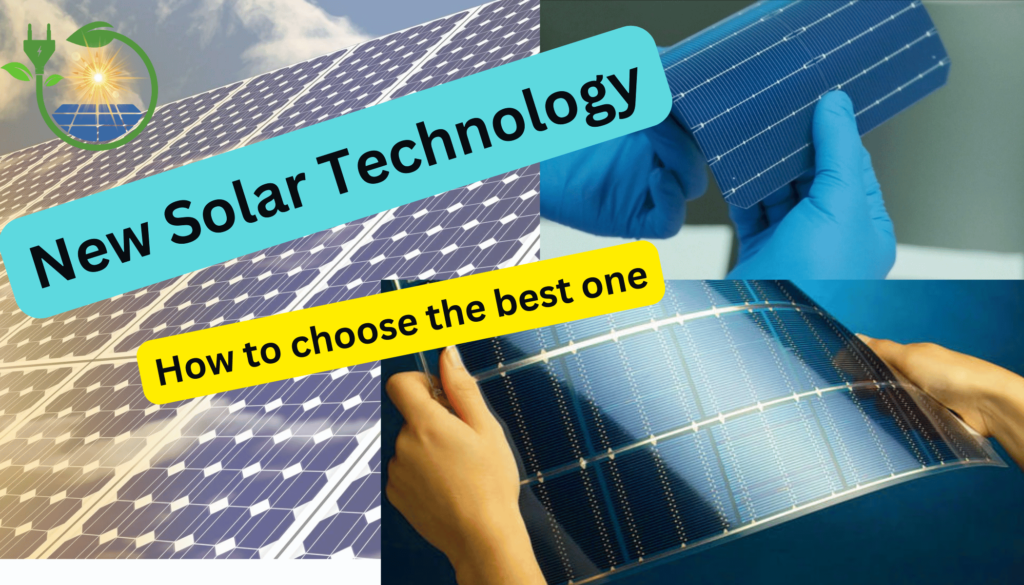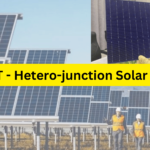How to Choose the Best Type of Solar Panels.
In the last few years, solar technology has evolved and open new door to significant innovations. Post-advance solar cells are engineered with efficiency, new and more abundant materials, advanced manufacturing techniques and flexible designs. This fast progress is taking the solar technology to more accessible and efficient products. It is ushering in a new era for solar photo-voltaic technology. Read further to understand the new technology in solar panels trending in 2024 shaping PV industry.
Solar Panels Efficiency Rates have skyrocketed in 2024:
Over the last decade, solar panel efficiency has achieved a remarkable advancement. In the early days of solar technology, solar panels had a conversion efficiency of 10-12%. It means that they could only convert the 10th of the sunlight they captured into useable electricity. But the continuous research, development, and technological breakthroughs, solar panels have achieved an efficiency rate up to 30%. The advancement is yet to be further progressing and lead the consumers up to maximum efficiency rate.
Nowadays, it is easy to find solar panels in markets with conversion efficiencies exceeding 25% or even up to 30%. It means that the solar photo-voltaic (PV) systems convert quarter or even more of the sunlight into renewable energy. The higher efficiency has made the solar energy a more viable and attractive option for consumers of commercial, homage and even entire cities. The advanced solar technology has not only occupied less space but also PV technology allows greater electricity production from the same amount of energy. This advanced solar technology is efficient in both high and low temperature.
This higher efficiency has got down the cost of solar power, making it more accessible and contributing to the widespread adoption of solar energy worldwide. The future certainly looks into brighter future of solar panel’s efficiency, and more further advancements are to be seen in near future.
Manufacturing Advancement: Perovskite Solar Cells:
As we can observe that the cost of solar panels has significantly decreased over the past few decades. It is finding ways to reduce the costs of manufacturing the solar panels. However, the affordability of solar modules is crucial for their widespread adoption. Today, most of the solar panels are made up of Silicon. Thus, the advance Perovskite solar cells have emerged as a promising solution due to the low production costs and very high efficiency.
Perocskite (PS) are semi-conductor material which is known for its crystalline structure which resembles Perovskite minerals. Perovskite semi-conductor can effectively convert sunlight into electricity due to its ability to absorb maximum range of wavelength, both visible and near-infrared spectra. It is low-costed and relatively simple manufacturing process. Along with it, further researches for improvement of solar efficiency and stability can be witnessed in solar industry. As a game-changer in the renewable energy industry, traditional Silicon-based semi-conductors are adopted for reducing the cost of solar energy.
Perovskite-silicon tandem solar cells are specified type of Perovskite variation which combines crystalline Silicon with a Perovskite layer. In this design, the crystalline Silicon substrate efficiency captures long wave-lengths, while PS excel at harnessing the short wave-length. The tandem cell architecture of PS cells exhibits a wide band-gap, resulting in high-performance characteristics.
Recent Announcements in Perovskite Solar Cell Research and Innovation:
Longi, a Chinese brand, has crossed the record-breaking efficiency with its Tandem solar cells. In December 2023, its tandem solar cells technology had reached an efficiency of 26.85%,which was a tremendous record at that time.
Scientists at the University of Colorado Boulder have invented a new method for the manufacturing of Peroskite cells. This technology is an advance development for commercializing next-generation solar requirements. This innovation in manufacturing techniques could play a crucial role in the advancement and wider adoption of Perovskite solar cells.
Despite the potential benefits of Peroskite solar cells, few challenges remain unsolved that must be addressed for its widespread commercial use. Researchers and innovative scientist are actively involved to further improve the stability and scalability of these cells. By resolving these issues, Perovskite solar cells could fill the gap and become a game-changer in the renewable energy industry. It offers a cost-effective and efficient alternative to traditional Silicon-based solar panels.
Bi-facial Solar Panels Captivate Most of the Sunlight:
Bi-facial solar panels can provide a unique advantage in solar energy generation by capturing sunlight from both sides, front and back, of the module. This innovative design allows these panels to utilize the reflected sunlight from various surfaces, such as the ground, water, or nearby structure , resulting in the increased electricity yield.
Bi-facial Solar Panel Technology:
Recent advancement in Bi-facial solar panel technology has contributed its share to the growing market in the renewable energy sector. The global Bi-facial solar panel market has witnessed a notable growth due to the increased demand for clean energy, improved efficiency, cost reduction and environmental benefits.
The versatility and efficiency of the Bi-facial solar panels has made them more valuable in various applications. Its application may ranges from commercial Photo-voltaic installations to large-scale solar farms, ultimately improving the economic viability of solar energy. Researchers at the National Renewable Energy Laboratory (NREL) are further exploring the development of Bi-facial Perovskite solar cells. They are further enhancing the potential of this cutting-edge technology for the upcoming generation.
Bi-facial Solar Panel Technology: Pros and Cons:
There are many advantages of the Bi-facial solar panel technology as depicted in the above description. But there are some drawbacks in the technology. The detail is as under:
Advantages of Bifacial Solar Panels
- Higher Energy Yield: Bifacial panels capture sunlight from both sides, resulting in increased energy production compared to traditional PV panels.
- Higher Cost: Bifacial panels are typically more expensive than traditional panels, making them a significant investment.
- Durability and Longevity: Bifacial panels are built to withstand environmental conditions, and many models were top performers on the 2024 PVEL PV Module Reliability Scorecard.
- Specialized Mounting: Bifacial panels require a different mounting system that allows light to reach both sides, which can increase installation complexity and cost.
- Better Performance in Diffuse Light: Bifacial panels have the ability to generate energy from diffuse or reflected light, making them suitable for areas with cloudy or low-light conditions.
- Aesthetic Considerations: The transparency of bifacial panels might not be visually appealing to some homeowners or commercial property owners.
- Increased Energy Output in Some Environments: Bifacial panels perform exceptionally well in certain environments, such as snow-covered regions or areas with highly reflective surfaces.
Disadvantages of Bifacial Solar Panels:
- Potential Dust and Dirt Accumulation: Because the backside of bifacial panels is exposed, there is a higher likelihood of dust and dirt accumulation on the backside, requiring more frequent cleaning and maintenance.
- Versatile Applications: Bifacial panels can be used in various applications, including rooftops, carports, and floating solar farms.
- Reduced Shadowing Effects: Due to their dual-sided design, bifacial panels are more susceptible to shadowing. Proper installation and spacing are crucial to minimize this effect.
- Solar Panels Become Flexible and Lightweight: The continuous advancements in materials and manufacturing techniques have paved the way for the emergence of flexible, thin, and lightweight solar panels, opening up a realm of possibilities for their application in diverse settings. These innovative solar panels are designed to be adaptable, making them well-suited for a range of uses, from powering portable devices to seamlessly fitting onto curved surfaces.
MIT researchers had developed ultra-light fabric solar cells, as thin as a human hair that can be easily affixed to any surface, creating a material like solar sheets. Weighing 1/100th of traditional solar panels, these PV cells produce 19 times more power-per-KG and are at the fore-front of the latest solar panel technology developments.
This development of flexible and lightweight solar panels transforms the utilization of renewable energy and revolutionized its integration into our daily lives. The flexible nature allows them for unconventional placements, including integration into clothing and backpacks. While, the light-weight design enhances their installation potential on various structures such as vehicles, buildings, and even spacecraft.
Its ability to be easily transported and deploy flexible solar sheets as a new technology is a significant advantage in remote and challenging environments in limited or non-existent areas. Due to its versatility and adaptability, these solar panels have become a game-changer in expanding its reach and accessibility of sustainable power generation.
Optimizing the Renewable Energy: Energy Storage:
In 2024, advancement can be seen in the integration of energy storage systems with solar panels. The key area of focus is the development of advanced technology of batteries, such as Lithium Ion and flow batteries, specially designed for solar energy storage. These advance battery systems offer a very high energy density, longer life-span, improved charging and discharging capabilities, allow more efficient utilization of stored solar energy, and guaranteed backup in off-grid situations. Lithium batteries have more capacity to store energy than acid batteries. The prices of Inverex batteries, Osaka batteries, Phoenix batteries, tabular batteries and Exide batteries are comparatively low than Lithium batteries but the capacity of Lithium batteries are far better than other batteries.
The advancement in battery management systems are anticipated by providing better optimization of energy storage. These systems have enabled its users to maximize the use of stored solar energy based on demand, grid conditions, or power costs. It ultimately leads to cost savings and increased energy efficiency.
In addition to technological advancement in storage batteries and solar panels, the integration of solar panels and storage batteries ensure benefits from improved governmental policies and regulations. Governments and consumers all over the world have recognized the value and potential of energy storage in renewable energy integration and grid stability. Therefore, 2024 may be expected to see more implementation of favorable incentives and support programs for the deployment of solar and storage systems. It may promote its widespread adoption in the clean renewable energy industry.
Transparent Solar Panels: Energy without Compromising Aesthetics:
With the innovation of transparent solar panels, the windows and building facades can now generate electricity and has ushered a new era of sustainable infrastructure. This advanced technology guarantees solar energy proficiency while preserving light transmission and visibility. These ground-breaking panels have employed Photo-voltaic (PV) technology, allowing for seamless integration into architectural elements such as windows and building exteriors. By utilizing PV glasses that maintains transparency, these panels serve dual purpose; creating visually appealing structures while generating renewable energy.
The transparent solar panels offer a unique solution that bends functionality with aesthetics. By harnessing the sun-power without obstructing natural light, this advance technology has enabled structures to be both energy producing and visually appealing. It may be incorporated in skyscrapers or residential buildings, transparent solar panels combine form and function, paving the way for greener and more sustainable future.
Rise of Smart Solar Panels: Unlock Efficiency and Performance:
The increased integration of smart new solar panel technology, including sensors and internet based capabilities, has revolutionized the solar panel industry. This integration enables superior monitoring, maintenance, and optimization of solar panel performance, leading to enhanced efficiency and effectiveness.
By implementing smart technologies in solar panels, the efficiency and life-span of solar PV arrays are significantly boosted. This advancement has promoted the most proactive and responsive method of generating solar electricity, laying the ground-work for a smarter, interconnected energy infra-structure with improved performance and sustainability.
By analyzing and automation of data, smart solar panels can adjust their solar energy production, track sunlight, and orientation proactively. It may ensure maximum electricity output and solar PV system reliability. This integration of smart technologies may enhance the overall effectiveness of solar panels and also paves the way for more interconnected and intelligent energy ecosystem. Due to the on-going advancements, the deployment of smart solar panels holds great potential in driving the wide-spread adaption of renewable energy and accelerating the use of solar Photo-voltaic technology.
FAQs: About Latest Solar Panels Technology Trends:
Q: Which U.S organization is researching new solar panels technology?
NREL is a major national renewable energy research organization working on the latest solar panel technology research. NREL conducts research studies on various solar related areas, such as advanced PV materials, device designs and testing, and solar PV manufacturing innovation. The researches aim to further improve solar cell conversion efficiencies and reduce the cost of PV technologies to make it more accessible and cost-effective. Other national organizations involved in solar technology research include Sandia National Laboratories, focusing on developing the advanced PV materials, systems, and devices for a sustainable energy future.
Other universities are also conducting researches on new solar panel technology. Stanford University’s Global Climate & Energy Project (GCEP) provides funding for researches in new technologies for clean energy and renewable resources, including solar power. The University of California, Berkeley, also provides a dedicated solar energy research group, which works on new solar cell technologies with higher efficiency. The Massachusetts Institute of Technology (MIT) has equipped a solar energy laboratory that works on various aspects of solar energy.
Additionally, some companies are conducting extensive researches on the development and commercialization of new solar panel technologies. Oxford PV is a UK-based company that has specialized in the development and commercialization of thin-film Perov-skite solar cells.
What new solar panel technologies are trending for 2024?
The latest solar panel technologies trend for 2024 including advancements in storage technology, improvements in solar cell efficiency, increased adoption of bifacial solar panels, and the incorporation of artificial intelligence and block-chain technology to streamline system management. Solar panel technological advancements may have a positive impact on the solar industry. It may also improve the efficiency and cost-effectiveness of solar panels, expands their applications, and increases their overall adoption.
How is block-chain technology used in the solar industry?
Block-chain technology is a Distributed Digital Ledger System which enables a secure, transparent, and decentralized energy trading in the solar technology with Virtual Power Plants (VPPs). It may allow peer-to-peer energy trading between consumers, producers, and system operators. It may work with no intermediaries, facilitating more efficient and reliable energy transactions.
Block-chain technology enhances the transparency and trace-ability of solar power transactions. It promotes the use of renewable energy sources and also enables the integration of distributed energy resources. It may facilitate micro-grids, improve operations and maintenance, and reduce transaction costs.
New Solar Panel Technology: Unlocking the Potential:
Solar PV module technology continues to evolve renewable energy feasibility. Through advancement in efficiency and advancements in materials and design, solar energy has become an increasingly accessible and versatile energy source.
The latest solar panel technology advancement is reshaping the way we think about energy. Its role in modern life and positioning of solar power is an essential part of the future of sustainable energy. The United States has accelerated the transition to renewable energy sources and unlocked a world of benefits for the environment and economy alike.
Green-Lancer was created for empowering the solar energy contractors with the expertise required to overcome solar permission and inter-connection obstacles. It has accelerated the deployment of clean energy infrastructure and has created a Green-Lancer account to begin shopping for solar design and engineering services.



